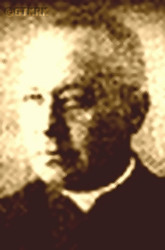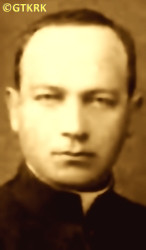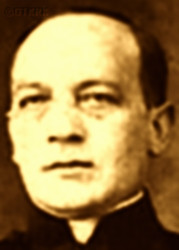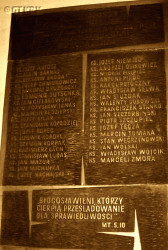Roman Catholic
St Sigismund parish
05-507 Słomczyn
85 Wiślana Str.
Konstancin deanery
Warsaw archdiocese, Poland
full list:
displayClick to display full list

searchClick to search full list by categories
wyświetlKliknij by wyświetlić pełną listę po polsku

szukajKliknij by przeszukać listę wg kategorii po polsku

Martyrology of the clergy — Poland
XX century (1914 – 1989)
personal data
religious status
Servant of God
surname
BRODA
forename(s)
Ceslav (pl. Czesław)
function
diocesan priest
creed
Latin (Roman Catholic) Church RCmore on
en.wikipedia.org
[access: 2014.09.21]
diocese / province
Przemyśl diocesemore on
www.przemyska.pl
[access: 2013.02.15]
RC Military Ordinariate of Polandmore on
en.wikipedia.org
[access: 2014.12.20]
honorary titles
Rochettum et Mantolettum canonmore on
en.wikipedia.org
[access: 2014.11.14]
(c. 1927)
Expositorii Canonicalis canonmore on
en.wikipedia.org
[access: 2014.11.14]
(c. 1922)
Merit Cross for Military Chaplains 2nd Class Silver (Austro–Hungarian Empire)more on
en.wikipedia.org
[access: 2023.12.15]
date and place
of death
12.12.1940

KL Dachauconcentration camp
today: Dachau, Upper Bavaria reg., Bavaria state, Germany
more on
en.wikipedia.org
[access: 2016.05.30]
alt. dates and places
of death
12.12.1942
details of death
In 1914, at the beginning of World War I conscripted into the army of Austro–Hungarian Empire as a chaplain. Ministered in the 10th Infantry Regiment (with a garrison in Przemyśl), on the Russian front (1914‐1915)., later in Tata–Tóváros and Szombathely, within the command of the 5th Corps, based in Bratislava. Demobilized in 1916 (decommissioned in 01.07.1917). — as a war invalid.
In 1923, 1924, 1925, 1927 and 1929 registered as a reserve chaplain of the Polish Army (from 25.11.1926 for a statutory period of 2 years).
After German invasion of Poland on 01.09.1939 (Russians invaded Poland 17 days later) and start of the World War II, after start of German occupation, arrested by the Germans for the first time on 03.11.1939 (or on c. 13.09.1939).
and held as a hostage.
Jailed in Rzeszów prison.
After a fortnight released.
Contributed then to the formation of the district headquarters of the underground resistance National Military Organization NOW in Leżajsk (which later became part of the Polish Clandestine State) — earlier, before the outbreak of the war, at the turn of the 1920s and 1930s, was vice‐president of the district board of the National Party, and in the spring of 1939 was elected to the city council in Leżajsk.
Arrested again on 23.07.1940 by the Germans, together with Leżajsk vicars and prefects, Fr Stanislav Lubas and Fr Thomas Pacuła, among others, prob. as a result of Ukrainian denouncement.
Jailed in Leżajsk, Yaroslav and Tarnów prisons.
Next c. two weeks later transported to KL Sachsenhausen concentration camp and from there on 06.09.1940 to KL Dachau concentration camp where perished.
According to the death certificate, prepared in KL Dachau, the „honest” otherwise German „medical doctors” and formalists — and at the same time, unrivaled fairy tale spinners — noted that the cause of death was Germ. „Versagen von Herz und Kreislauf” (Eng. „Heart and circulatory failure”).
prisoner camp's numbers
18218Click to display source page (KL DachauClick to display the description), 29267 (KL SachsenhausenClick to display the description)
cause of death
extermination: exhaustion and starvation
perpetrators
Germans
sites and events
KL DachauClick to display the description, KL SachsenhausenClick to display the description, TarnówClick to display the description, JarosławClick to display the description, RzeszówClick to display the description, «Intelligenzaktion»Click to display the description, Collective responsibility („Hostages”)Click to display the description, Ribbentrop‐MolotovClick to display the description, Pius XI's encyclicalsClick to display the description
date and place
of birth
05.02.1885

Słocinatoday: district of Rzeszów, Rzeszów city pov., Subcarpathia voiv., Poland
more on
en.wikipedia.org
[access: 2021.10.09]
parents
BRODA Marcel
🞲 ?, ? — 🕆 ?, ?

SMOLIK Caroline
🞲 ?, ? — 🕆 ?, ?
presbyter (holy orders)
ordination
24.06.1909

Przemyśltoday: Przemyśl city pov., Subcarpathia voiv., Poland
more on
en.wikipedia.org
[access: 2021.04.01]
Assumption of the Blessed Virgin Mary and St John the Baptist RC cathedral churchmore on
en.wikipedia.org
[access: 2025.03.14]
positions held
1929 – 1940
dean — Leżajsktoday: Leżajsk urban gm., Leżajsk pov., Subcarpathia voiv., Poland
more on
en.wikipedia.org
[access: 2021.10.09] RC deanery
1925 – 1940
parish priest — Leżajsktoday: Leżajsk urban gm., Leżajsk pov., Subcarpathia voiv., Poland
more on
en.wikipedia.org
[access: 2021.10.09] ⋄ Holy Trinity, Blessed Virgin Mary and All the Saints RC parish ⋄ Leżajsktoday: Leżajsk urban gm., Leżajsk pov., Subcarpathia voiv., Poland
more on
en.wikipedia.org
[access: 2021.10.09] RC deanery
1926 – 1929
deputy dean — Leżajsktoday: Leżajsk urban gm., Leżajsk pov., Subcarpathia voiv., Poland
more on
en.wikipedia.org
[access: 2021.10.09] RC deanery
1939
membership — Leżajsktoday: Leżajsk urban gm., Leżajsk pov., Subcarpathia voiv., Poland
more on
en.wikipedia.org
[access: 2021.10.09] ⋄ City Council
1919 – 1925
curatus/rector/expositus — Wola Raniżowskatoday: Raniżów gm., Kolbuszowa pov., Subcarpathia voiv., Poland
more on
en.wikipedia.org
[access: 2021.10.09] ⋄ St Adalbert the Bishop and Martyr RC church ⋄ Raniżówtoday: Raniżów gm., Kolbuszowa pov., Subcarpathia voiv., Poland
more on
en.wikipedia.org
[access: 2021.10.09], Assumption of the Blessed Virgin Mary RC parish ⋄ Głogów Małopolskiform.: Głogów
today: Głogów Małopolski gm., Rzeszów pov., Subcarpathia voiv., Poland
more on
en.wikipedia.org
[access: 2010.08.11] RC deanery — also: prefect of a primary school and founder of the church (to raise appropriate funds, twice in 1918‐1919 went to the United States)
c. 1923
administrator — Nowy Narttoday: Nowy Nart, Jeżowe gm., Nisko pov., Subcarpathia voiv., Poland
more on
en.wikipedia.org
[access: 2021.10.09] ⋄ Our Lady of Perpetual Help RC church ⋄ Raniżówtoday: Raniżów gm., Kolbuszowa pov., Subcarpathia voiv., Poland
more on
en.wikipedia.org
[access: 2021.10.09], Assumption of the Blessed Virgin Mary RC parish ⋄ Głogów Małopolskiform.: Głogów
today: Głogów Małopolski gm., Rzeszów pov., Subcarpathia voiv., Poland
more on
en.wikipedia.org
[access: 2010.08.11] RC deanery — acting („ad interim”)
1914 – 1917
RC military chaplain — Austro–Hungarian Imperial Army — decommissioned on 01.07.1917; in c. 1921 recognised by the Polish Army as military chaplain, verified with seniority from 01.06.1919, in the rank of captain
1911 – c. 1919
prefect — Wola Raniżowskatoday: Raniżów gm., Kolbuszowa pov., Subcarpathia voiv., Poland
more on
en.wikipedia.org
[access: 2021.10.09] ⋄ people's school ⋄ Raniżówtoday: Raniżów gm., Kolbuszowa pov., Subcarpathia voiv., Poland
more on
en.wikipedia.org
[access: 2021.10.09], Assumption of the Blessed Virgin Mary RC parish ⋄ Głogów Małopolskiform.: Głogów
today: Głogów Małopolski gm., Rzeszów pov., Subcarpathia voiv., Poland
more on
en.wikipedia.org
[access: 2010.08.11] RC deanery — also: in 4‐grade elementary school in Mazury (1911); with a break for service in the Austro–Hungarian Monarchy's army in the first years of World War I
1909 – 1911
vicar — Turkaform.: Turka on Stryi river
today: Turka urban hrom., Sambir rai., Lviv obl., Ukraine
more on
en.wikipedia.org
[access: 2021.02.12] ⋄ Assumption of the Blessed Virgin Mary RC parish ⋄ Sambirtoday: Sambir urban hrom., Sambir rai., Lviv obl., Ukraine
more on
en.wikipedia.org
[access: 2021.02.12] RC deanery
1905 – 1909
student — Przemyśltoday: Przemyśl city pov., Subcarpathia voiv., Poland
more on
en.wikipedia.org
[access: 2021.04.01] ⋄ philosophy and theology, Theological Seminary
author of „The Foaming Men” theatre play
comments
The urn with ashes — cremation prob. took place in the crematorium at the Germ. Ostfriedhof (Eng. Eastern cemetery) in Munich — since 1950 has been kept at the Am Perlacher Forst cemetery, in a place known as Germ. Ehrenhain I (Eng. „Remembrance Grove No. 1”), in Munich. In 2013, information about the „disclosure” of the cremated remains of the KL Dachau victims made it to the front pages of news outlets. His urn bears the No. D4032.
others related
in death
LUBASClick to display biography Stanislav
sites and events
descriptions
KL Dachau: KL Dachau in German Bavaria, set up in 1933, became the main German Germ. Konzentrationslager (Eng. concentration camp) KL for Catholic priests and religious during World War II: On c. 09.11.1940, Reichsführer‐SS Heinrich Himmler, head of the SS, Gestapo and German police, as a result of the Vatican's intervention, decided to transfer all clergymen detained in various concentration camps to KL Dachau camp. The first major transports took place on 08.12.1940. In KL Dachau Germans held approx. 3,000 priests, including 1,800 Poles. The priests were forced to slave labor in the Germ. „Die Plantage” — the largest herb garden in Europe, managed by the genocidal SS, consisting of many greenhouses, laboratory buildings and arable land, where experiments with new natural medicines were conducted — for many hours, without breaks, without protective clothing, no food. They slaved in construction, e.g. of camp's crematorium. In the barracks ruled hunger, freezing cold in the winter and suffocating heat during the summer, especially acute in 1941‐1942. Prisoners suffered from bouts of illnesses, including tuberculosis. Many were victims of murderous „medical experiments” — in 11.1942 c. 20 were given phlegmon injections; in 07.1942 to 05.1944 c. 120 were used by for malaria experiments. More than 750 Polish clerics where murdered by the Germans, some brought to TA Hartheim euthanasia centre set up in Schloss Hartheim in Austria and murdered in gas chambers. At its peak KL Dachau concentration camps’ system had nearly 100 slave labour sub‐camps located throughout southern Germany and Austria. There were c. 32,000 documented deaths at the camp, and thousands perished without a trace. C. 10,000 of the 30,000 inmates were found sick at the time of liberation, on 29.04.1945, by the USA troops… (more on: www.kz-gedenkstaette-dachau.deClick to attempt to display webpage
[access: 2013.08.10], en.wikipedia.orgClick to attempt to display webpage
[access: 2016.05.30])
KL Sachsenhausen: In Germ. Konzentrationslager (Eng. concentration camp) KL Sachsenhausen, set up in the former Olympic village in 07.1936, hundreds of Polish priests were held in 1940, before being transported to KL Dachau. Some of them perished in KL Sachsenhausen. Murderous medical experiments on prisoners were carried out in the camp. In 1942‐1944 c. 140 prisoners slaved at manufacturing false British pounds, passports, visas, stamps and other documents. Other prisoners also had to do slave work, for Heinkel aircraft manufacturer, AEG and Siemens among others. On average c. 50,000 prisoners were held at any time. Altogether more than 200,000 inmates were in jailed in KL Sachsenhausen and its branched, out of which tens of thousands perished. Prior to Russian arrival mass evacuation was ordered by the Germans and c. 80,000 prisoners were marched west in so‐called „death marches” to other camps, i.e. KL Mauthausen‐Gusen and KL Bergen‐Belsen. The camp got liberated on 22.04.1945. After end of armed hostilities Germans set up there secret camp for German prisoners and „suspicious” Russian soldiers. (more on: en.wikipedia.orgClick to attempt to display webpage
[access: 2018.11.18])
Tarnów: The prison commissioned on 29.11.1926, considered at that time to be the most modern of its kind in Europe. During World War II and the German occupation, it functioned under the name of Germ. Deutsche Strafanstalt Tarnów (Eng. Penal Institution Tarnów) and was initially used as a transit camp for Polish prisoners of war, and then as a prison of the German political police Gestapo. In total, the Germans held about 25,000 Poles there. Many of them were shot by the Germans in the surrounding villages, others were transported to concentration camps. Among others, on 14.06.1940, a transport of 728 prisoners, who became the first prisoners of the newly established German concentration camp KL Auschwitz, was sent from the Tarnów prison. Later, about 50 such transports were sent to KL Auschwitz, and others to KL Sachsenhausen, KL Gross Rosen, KL Ravensbruck, KL Płaszów, and the children's camp in Łódź. After the end of the military operations of World War II and the beginning of the Russian occupation, political prisoners, opponents of the Commie‐Nazi regime of the Russian republic known as prl, were also held there. (more on: www.sw.gov.plClick to attempt to display webpage
[access: 2013.08.17])
Jarosław: In the former benedictine priory buildings Germans set up a prison and detention centre. „Few thousands victims” were murdered there. After German defeat in 1944 and start of another Russian occupation a camp for Polish and then Ukrainian political prisoners was set up, run initially prob. by the Russians and then by Commie‐Nazi UB organization — branch of Russian NKVD. (more on: www.sztetl.org.plClick to attempt to display webpage
[access: 2013.08.10])
Rzeszów: During German occupation penal prison run by the Germans set up in Rzeszów Castle. At any one time more than 2,500 prisoners were held there (for instance from 01.04.1943 till 01.03.1944), mainly Poles. In the Castle basements and on prison yard executions were carried out of those sentenced by the German Sondergericht (Eng. special court) kangaroo court — other prisoners of the Castle were executed by the Germans at other sites in Rzeszów as well. After German withdrawal on 02.08.1944 and capture of Rzeszów by the Russians the prison was taken over initially by the Russian genocidal NKVD and then by Polish UB, a unit of murderous Russian NKVD. Thousands, of prisoners — Polish political activists and partisans, members of various clandestine organizations (among others from Home Army AK, part of Polish Clandestine State, and Freedom and Independence WiN) — were then held captive there. Local AK leader, Col. Lukas Ciepliński, future chairman of 4th Command of WiN, murdered by Commie‐Nazis in 1951, reported in 1944 that „during interrogations even women are brutally beaten. The processes […] are led by NKVD” and „the prisoners’ situation […] is dreadful. They simply perish from hunger. The food in German times compared to today was simply a luxury”. Executions of those held — Polish independence activists, but also German war criminals and Ukrainian nationalist — were also, as done by the Germans, carried out then in the Castle, in Castle’s basements and on the gallows in the prison yard. (more on: www.sw.gov.plClick to attempt to display webpage
[access: 2013.12.04])
«Intelligenzaktion»: German: «Intelligenzaktion» (English: „Intelligence Action”) — a German program of extermination of the Polish elite, mainly the intelligentsia and leadership layers, carried out from the beginning of the occupation in w 09.1939 to 04.1940, mainly in territories directly annexed to Germany, but also in the so‐called Germ. Generalgouvernement (Eng. General Governorate), where it was called «AB‐aktion». In the first phase, immediately after the beginning of the German occupation, during military operations carried out by the Germ. Wehrmacht (Eng. Armed Forces) and the genocidal units of the Germ. Einsatzgruppen (Eng. Operational Groups) of the Germ. Sicherheitspolizei (Eng. Security Police), i.e. SiPo, and Germ. Sicherheitsdienst des Reichsführers SS (Eng. Security Service of the Reichsführer SS), i.e. SD, organized by the Germ. Reichssicherheitshauptamt (Eng. Reich Main Security Office), i.e. RSHA, which followed the troops, carried out under the Germ. Unternehmen „Tannenberg” (Eng. Operation „Tannenberg”) — based on the so‐called Germ. Sonderfahndungsliste (Eng. Special Wanted Lists), i.e. proscription lists of Poles considered particularly dangerous to the Third Reich, prepared by the Zentralstelle II/P (Polen) unit of the German RSHA. Later, implemented by the German civilian occupation authorities and the genocidal unit of the Germ. Volksdeutscher Selbstschutz (Eng. Ethnic Germans Self‐Defense), whose members were Germ. Volksdeutsche (Eng. Ethnic Germans), i.e. representatives of the German minority in Poland. According to various sources, these lists, at the beginning of 09.1939, could have contained the details of 61,000—88,000 „dangerous” Poles — although these figures cannot be confirmed. In total, during this genocide, c. 50,000 teachers, Catholic priests, representatives of the landed gentry, freelancers, social and political activists, and retired military personnel were systematically and methodically murdered. Another 50,000 were sent to concentration camps, where only a negligible percentage survived. (more on: en.wikipedia.orgClick to attempt to display webpage
[access: 2014.10.04])
Collective responsibility („Hostages”): A criminal practice implemented by the Germans in the occupied territories of Poland, applied from the very first day of World War II. At its core was an appointment and public announcement of a list of names of selected people whose lives depended on absolute compliance with German orders. Any violation of these ordinances, by any person, regardless of the circumstances, resulted in the murder of the designated „hostages”. In the first days of the war and occupation, it was used i.a. by the German Wehrmacht army to prevent acts of continuation of the defense by the Poles. Later, especially in the German‐run General Governorate, it was part of the official policy of the occupation authorities — collective responsibility for any acts of resistance to the occupier's practices. For the life of one German, even if death was due to customary reasons, the Germans carried out executions from a dozen to even a hundred Poles previously designated as „hostages”.
Ribbentrop‐Molotov: Genocidal Russian‐German alliance pact between Russian leader Joseph Stalin and German leader Adolf Hitler signed on 23.08.1939 in Moscow by respective foreign ministers, Mr. Vyacheslav Molotov for Russia and Joachim von Ribbentrop for Germany. The pact sanctioned and was the direct cause of joint Russian and German invasion of Poland and the outbreak of the World War II in 09.1939. In a political sense, the pact was an attempt to restore the status quo ante before 1914, with one exception, namely the „commercial” exchange of the so‐called „Kingdom of Poland”, which in 1914 was part of the Russian Empire, fore Eastern Galicia (today's western Ukraine), in 1914 belonging to the Austro‐Hungarian Empire. Galicia, including Lviv, was to be taken over by the Russians, the „Kingdom of Poland” — under the name of the General Governorate — Germany. The resultant „war was one of the greatest calamities and dramas of humanity in history, for two atheistic and anti‐Christian ideologies — national and international socialism — rejected God and His fifth Decalogue commandment: Thou shall not kill!” (Abp Stanislav Gądecki, 01.09.2019). The decisions taken — backed up by the betrayal of the formal allies of Poland, France and Germany, which on 12.09.1939, at a joint conference in Abbeville, decided not to provide aid to attacked Poland and not to take military action against Germany (a clear breach of treaty obligations with Poland) — were on 28.09.1939 slightly altered and made more precise when a treaty on „German‐Russian boundaries and friendship” was agreed by the same murderous signatories. One of its findings was establishment of spheres of influence in Central and Eastern Europe and in consequence IV partition of Poland. In one of its secret annexes agreed, that: „the Signatories will not tolerate on its respective territories any Polish propaganda that affects the territory of the other Side. On their respective territories they will suppress all such propaganda and inform each other of the measures taken to accomplish it”. The agreements resulted in a series of meeting between two genocidal organization representing both sides — German Gestapo and Russian NKVD when coordination of efforts to exterminate Polish intelligentsia and Polish leading classes (in Germany called «Intelligenzaktion», in Russia took the form of Katyń massacres) where discussed. Resulted in deaths of hundreds of thousands of Polish intelligentsia, including thousands of priests presented here, and tens of millions of ordinary people,. The results of this Russian‐German pact lasted till 1989 and are still in evidence even today. (more on: en.wikipedia.orgClick to attempt to display webpage
[access: 2015.09.30])
Pius XI's encyclicals: Facing the creation of two totalitarian systems in Europe, which seemed to compete with each other, though there were more similarities than contradictions between them, Pope Pius XI issued in 03.1937 (within 5 days) two encyclicals. In the „Mit brennender Sorge” (Eng. „With Burning Concern”) published on 14.03.1938, condemned the national socialism prevailing in Germany. The Pope wrote: „Whoever, following the old Germanic‐pre‐Christian beliefs, puts various impersonal fate in the place of a personal God, denies the wisdom of God and Providence […], whoever exalts earthly values: race or nation, or state, or state system, representatives of state power or other fundamental values of human society, […] and makes them the highest standard of all values, including religious ones, and idolizes them, this one […] is far from true faith in God and from a worldview corresponding to such faith”. On 19.03.1937, published „Divini Redemptoris” (Eng. „Divine Redeemer”), in which criticized Russian communism, dialectical materialism and the class struggle theory. The Pope wrote: „Communism deprives man of freedom, and therefore the spiritual basis of all life norms. It deprives the human person of all his dignity and any moral support with which he could resist the onslaught of blind passions […] This is the new gospel that Bolshevik and godless communism preaches as a message of salvation and redemption of humanity”… Pius XI demanded that the established human law be subjected to the natural law of God , recommended the implementation of the ideal of a Christian state and society, and called on Catholics to resist. Two years later, National Socialist Germany and Communist Russia came together and started World War II. (more on: www.vatican.vaClick to attempt to display webpage
[access: 2023.05.28], www.vatican.vaClick to attempt to display webpage
[access: 2023.05.28])
sources
personal:
prawy.plClick to attempt to display webpage
[access: 2016.11.06], nawolyniu.plClick to attempt to display webpage
[access: 2013.01.06], www.ipgs.usClick to attempt to display webpage
[access: 2012.11.23]
bibliographical:
„Register of Latin rite Lviv metropolis clergy’s losses in 1939‐45”, Józef Krętosz, Maria Pawłowiczowa, editors, Opole, 2005
„Biographical lexicon of Lviv Roman Catholic Metropoly clergy victims of the II World War 1939‐1945”, Mary Pawłowiczowa (ed.), Fr Joseph Krętosz (ed.), Holy Cross Publishing, Opole, 2007
„Urns kept at the Am Perlacher Forst cemetery — analysis”, Mr Gregory Wróbel, curator of the Museum of Independence Traditions in Łódź, private correspondence, 25.05.2020
„Schematismus Venerabilis Cleri Dioecesis PremisliensisClick to display source page”, Przemyśl diocesa Curia, from 1866 to 1938
„International Tracing Service (ITS), Bad Arolsen, GermanyClick to display source page”, Arolsen Archives
original images:
www.rzeszow.mw.org.plClick to attempt to display webpage
[access: 2016.11.06], www.parafia.wolaranizowska.plClick to attempt to display webpage
[access: 2021.10.09], prawy.plClick to attempt to display webpage
[access: 2016.11.06], www.miejscapamiecinarodowej.plClick to attempt to display webpage
[access: 2014.08.14]
LETTER to CUSTODIAN/ADMINISTRATOR
If you have an Email client on your communicator/computer — such as Mozilla Thunderbird, Windows Mail or Microsoft Outlook, described at WikipediaPatrz:
en.wikipedia.org, among others — try the link below, please:
LETTER to CUSTODIAN/ADMINISTRATORClick and try to call your own Email client
If however you do not run such a client or the above link is not active please send an email to the Custodian/Administrator using your account — in your customary email/correspondence engine — at the following address:

giving the following as the subject:
MARTYROLOGY: BRODA Ceslav
To return to the biography press below:
 Click to return to biography
Click to return to biography











